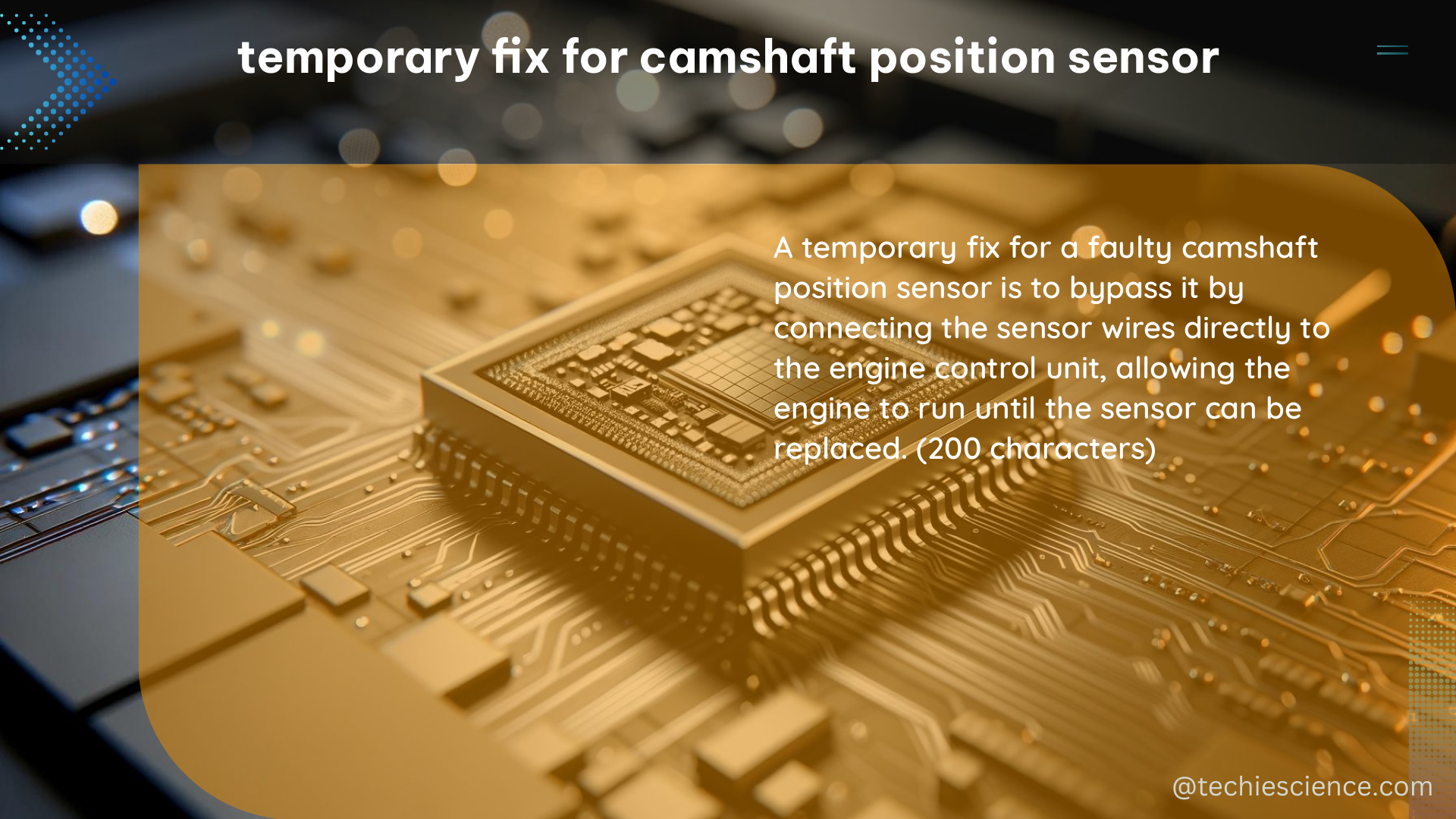A camshaft position sensor is a critical component in modern vehicle engines, responsible for providing the engine control unit (ECU) with information about the position and timing of the camshaft. When this sensor fails, it can cause a range of issues, including engine misfiring, poor fuel economy, and even engine stalling. While a permanent solution is ultimately required, a temporary fix can help you get your vehicle back on the road until a proper repair can be made.
Identifying a Faulty Camshaft Position Sensor
The first step in performing a temporary fix for a camshaft position sensor is to diagnose the issue. Common symptoms of a faulty camshaft position sensor include:
- Engine Misfiring: If the camshaft position sensor is not providing accurate information to the ECU, it can cause the engine to misfire, leading to a rough idle and reduced performance.
- Poor Fuel Economy: A malfunctioning camshaft position sensor can cause the ECU to adjust the fuel-air mixture incorrectly, resulting in decreased fuel efficiency.
- Engine Stalling: In some cases, a faulty camshaft position sensor can cause the engine to stall, especially at idle or during acceleration.
- Check Engine Light: The ECU will typically detect a problem with the camshaft position sensor and illuminate the check engine light on the dashboard.
Testing the Camshaft Position Sensor

To perform a temporary fix for a camshaft position sensor, you’ll need to use a multimeter to test the sensor’s resistance. Here’s how to do it:
- Locate the Camshaft Position Sensor: The camshaft position sensor is typically located near the crankshaft pulley or the cylinder head, depending on the make and model of your vehicle.
- Disconnect the Electrical Connector: Carefully disconnect the electrical connector from the camshaft position sensor.
- Set the Multimeter: Set your multimeter to the ohms (Ω) setting.
- Measure the Resistance: Touch the multimeter probes to the terminals of the camshaft position sensor. The resistance should be between 800 and 1200 ohms when the engine is not running.
- Interpret the Results: If the resistance reading is within the expected range, the sensor is likely functioning properly. If the reading is outside this range, the sensor may be faulty and require replacement.
Temporary Fix Procedure
If the camshaft position sensor is reading outside the expected resistance range, you can try a temporary fix by bypassing the sensor. Here’s how to do it:
- Locate the Camshaft Position Sensor Wiring Harness: Trace the wiring harness from the camshaft position sensor to the ECU or the engine control module (ECM).
- Identify the Sensor Wiring Terminals: Determine which wires in the harness are connected to the camshaft position sensor. Typically, there will be three wires: a power supply, a ground, and a signal wire.
- Bypass the Sensor: Using a jumper wire, connect the power supply and signal wires together. This will effectively bypass the camshaft position sensor and allow the engine to run, albeit with reduced performance and fuel efficiency.
It’s important to note that this temporary fix is not a permanent solution and should only be used as a short-term measure to get your vehicle back on the road. The underlying issue causing the camshaft position sensor to fail must be addressed as soon as possible to avoid further damage to your engine.
Camshaft Position Sensor Specifications
The technical specifications for a camshaft position sensor can vary depending on the make and model of your vehicle. However, some common specifications include:
| Specification | Range |
|---|---|
| Resistance | 800 to 1200 ohms (when the engine is not running) |
| Voltage | 4.5 to 5.5 volts |
| Current Draw | 10 to 20 milliamps |
| Temperature Range | -40 to +150 degrees Celsius |
| Mounting Orientation | Vertical or horizontal |
These specifications can help you ensure that a replacement camshaft position sensor is compatible with your vehicle’s engine and electrical system.
Conclusion
A temporary fix for a camshaft position sensor can be a useful solution to get your vehicle back on the road, but it’s important to remember that it’s not a permanent fix. By following the steps outlined in this guide, you can diagnose and temporarily bypass a faulty camshaft position sensor, but you should still seek a permanent solution as soon as possible to avoid further damage to your engine.
References
- SUPPLIER HANDBOOK DOCUMENT REVISION HISTORY TRACKER, Hitachi Automotive, 2021-05-20, https://www.hitachi-automotive.us/Supplier/Handbook/Supplier%20Handbook%20Condensed%2010.13.2021.pdf
- Ford Speak: Acronyms, Definitions, and Terms, Ford, https://elsmar.com/Cove_Premium/Ford%20attachments/FORDAcronymsbooklet%5B1%5D.pdf
- Heavy-Duty Engines and Vehicles:Regulatory Impact Analysis, EPA, https://nepis.epa.gov/Exe/ZyPURL.cgi?Dockey=P100EG9C.TXT

The lambdageeks.com Core SME Team is a group of experienced subject matter experts from diverse scientific and technical fields including Physics, Chemistry, Technology,Electronics & Electrical Engineering, Automotive, Mechanical Engineering. Our team collaborates to create high-quality, well-researched articles on a wide range of science and technology topics for the lambdageeks.com website.
All Our Senior SME are having more than 7 Years of experience in the respective fields . They are either Working Industry Professionals or assocaited With different Universities. Refer Our Authors Page to get to know About our Core SMEs.